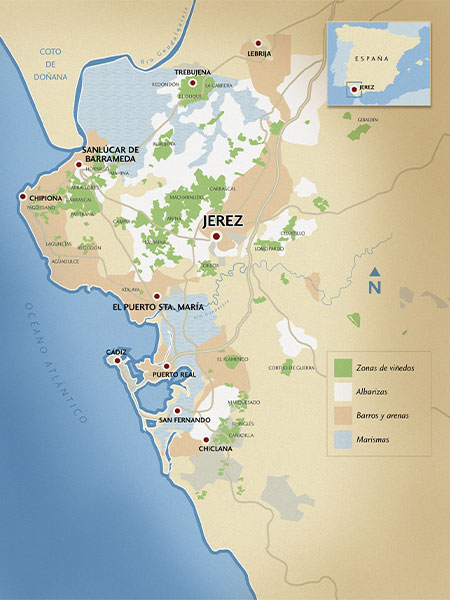Sweeping changes have been approved by the Consejo Regulador de las Denominaciones de Origen “Jerez-Xérès-Sherry.” In this conservative region, these decrees may mark a revolution. No area of Sherry-making is left untouched, from vineyards to grapes to fortification to aging regulations and labeling. According to César Saldaña, president of the Consejo Regulador, there have been years of discussions, only becoming public in September of 2021. “We have all agreed,” he says, “that it is time to give greater relevance to the viticultural aspects, which we put aside in recent decades. We had privileged the work in the winery and the goal of producing more and more.”


A map of the Jerez vineyards, undertaken by the Consejo in 2015, officially delimits the historical pagos of Jerez; Balbaína, Macharnudo and Carrascal are all names that have been known for centuries, but now, they have well-defined borders. “There are about 120 pagos that the Consejo Regulador can now certify with precision,” Saldaña says. “This allows us to give producers the freedom to use those names on the labels, as long as at least 85 percent of the grapes come from a certain pago.”
The map of the crianza area has also changed: Until now, for wine to be covered by the D.O., Jerez-Xérès-Sherry had to age in one of the three corners of the so-called triangle: Jerez, Sanlúcar de Barrameda and El Puerto de Santa María (though the grapes could come from other places within the D.O.). Now, the bodegas of Trebujena, Lebrija, Chipiona, Rota, Chiclana and Puerto Real will be able to make and age their wines locally and still label them Jerez-Xérès-Sherry. “This is, more than anything, a historical claim,” according to Saldaña. “Jerez, Sanlúcar de Barrameda and Puerto de Santa María have just over 340,000 botas (500-liter barrels), while the other six do not reach 10,000 [combined].”
For more than a century, there have been three permitted varieties for Sherry production—palomino fino, pedro ximénez and moscatel. But now, seven more are authorized; all have historic ties to the region, but were forgotten after phylloxera hit at the end of the 19th century. The newly authorized grapes are beba, cañocazo, mantúo, castellano, mantúo de pilas, perruno and vigiriega. “Before phylloxera, 43 types of grapes had been registered; some of them [which ripened early], such as palomino, were destined for biologically-aged wines,” as in, Fino and Manzanilla, says Ramiro Ibáñez, proprietor of Cota 45 in Sanlúcar de Barrameda. “Others, slower to ripen, were left for oxidative-aging wines (Amontillado). The type of wine (e.g., Fino or Amontillado) was largely determined by the variety of grape.”
Perhaps the most striking change approved by the Consejo is the option not to fortify the wines. In fact, the addition of alcohol to gird the wine for long aging has only recently become widespread. In the middle of the 19th century, when producers adapted the criadera and solera system, grape bunches were left to dehydrate in the sun—asoleados—to concentrate their sugars and raise the potential alcohol in the wine. “Until 1969 it was mandatory to asolear,” Ibáñez says. “All the prestigious wineries had an area in their cellars, the almíjar, to deposit the bunches. But the Consejo lifted that obligation and, since then, adding alcohol has become common.”


“Before phylloxera, 43 types of grapes had been registered; some of them, such as palomino, were destined for biologically-aged wines (e.g., Fino). Others, slower to ripen, were left for oxidative-aging wines (Amontillado).”
Ramiro Ibanez of Cota 45
The new legislation will allow for wines that have not been fortified, but which do have at least 15 degrees of alcohol at the time of bottling and have then aged for at least two years before release. This opens the door to another aspiration of some producers in Jerez: the return of de pasto wines—wines without fortification at less than 15 degrees of alcohol. Saldaña cites the new rules as a step to recover those historic wines. “But for now,” he says, “we have left it pending. A great advance is that fortification will no longer be necessary.”
Another change, which will undoubtedly provoke interest among Jerez fans, is the introduction of two new categories for biologically-aged wines older than seven years: Manzanilla Pasada from Sanlúcar de Barrameda and Fino Viejo, from the rest of the denomination. “We have set the limit at seven years because, although there are exceptions, it is the time when the activity of the veil of flor has already declined.” Saldaña says.
Now that these modifications have been approved by the Consejo Regulador, they must be ratified by the Junta de Andalucía and by the Spanish government before being sent to the European Union for final approval. Saldaña is hopeful that, by September 2022, they will come into effect.
is the author of Descorchados, an annual guide to the wines of South America, and covers Chile for W&S.
This story appears in the print issue of December 2021.
Like what you read? Subscribe today.
















